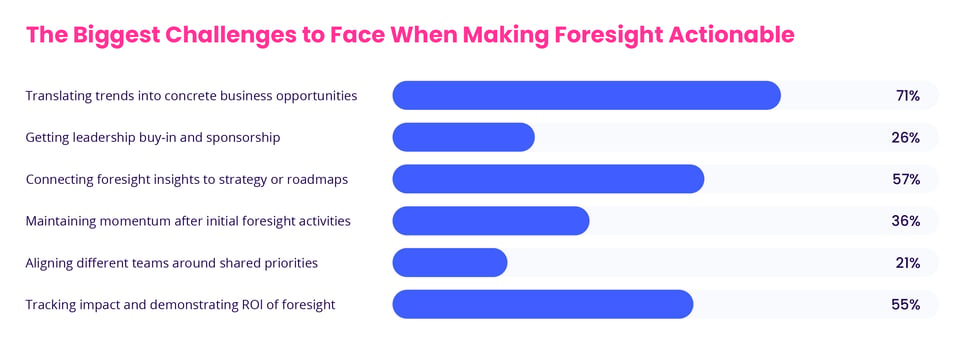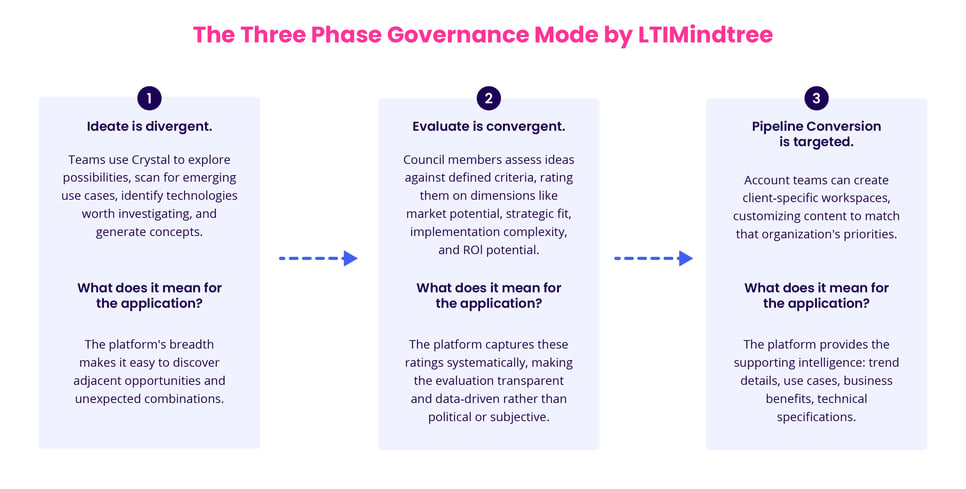The gap between disruption and displacement keeps shrinking. Business decisions are increasingly loaded with risk. Technologies that once took decades to mature now hit market saturation in months. For global enterprises, this creates tough choices: invest early and risk betting on hype, or wait for clarity and lose the lead.
This reality shaped the discussion in the webinar on strategic foresight with LTIMindtree's Sachin Jain (Research & Innovation Leader) and Bharat Trivedi (Research & Innovation Leader). During the session, participants were asked: "What are the biggest challenges you face when trying to make foresight actionable in your organization?".
And the results told a familiar story (Exhibit 1):

Exhibit 1: The biggest challenges to face when making foresight actionable
These numbers reflect a shared global tension: foresight often produces insights, but no action. Teams gather trends and signals and don't translate them into strategic choices, investments, or innovation priorities afterwards.
LTIMindtree faced the same challenge: As a global consulting firm serving enterprise clients across different industries, its foresight function had to keep pace with accelerating change. Their research and innovation team had built a solid foresight practice called Tech Beacon, and it worked. But as client demands intensified and technology cycles shortened, the model could no longer scale. To stay ahead, there was a clear need to expand innovation efforts and capabilities.
The world was changing faster than our ability to publish reports. We needed a system that could see change as it happens, not after the fact.
– Bharat Trivedi, Principal Enterprise Architecture, LTIMindtree
So they built something different. Crystal, their innovation platform powered by ITONICS, was developed to allow companies to achieve long-term success in a rapidly changing world. It transformed foresight from a periodic research exercise into an always-on intelligence system. The results speak clearly: 600+ trends tracked, 13,000 active users, 35+ new client engagements, and a 30% increase in pipeline conversion.
The story of LTIMindtree goes beyond the usual story of adopting software: It’s about operationalizing strategic foresight at scale, democratizing intelligence across thousands of employees, and turning trend analysis into client-ready narratives that win deals. Crystal also supports project management and helps drive efficiency across innovation activities. Here’s how they did it.
These efforts help LTIMindtree achieve its strategic goals and deliver greater value to its clients.
Why strategic foresight matters: moving from reactive to proactive innovation
Strategic foresight has become the mechanism that separates leaders from followers in markets shaped by AI acceleration, shifting customer behavior, and sudden competitive shocks. To move from reactive to proactive innovation, organizations need more than trend scans. They need the ability to detect signals early, decide with clarity, and act before the market forces their hand.
Bharat Trivedi summarized it perfectly:
Foresight cannot live with a few experts. We wanted thousands of minds thinking about what is next, together.
– Bharat Trivedi, Principal Enterprise Architecture, LTIMindtree
During the webinar, this shift was clear: 71% of participants said they struggle to translate trends into business opportunities, 57% find it difficult to connect foresight to strategy or roadmaps, and 55% struggle to track ROI. The takeaway was simple: most companies have plenty of insight, but too little impact.
The "So What?" question: Turning foresight into actionable decisions
For most organizations, foresight remains trapped in reports and PowerPoint decks. Teams analyze trends, but insights rarely reach those making real business decisions. This is what Emily, Senior Innovation Consultant at ITONICS, described in the webinar as the "So What?" problem: a persistent gap between insights and action.
The question reflects the challenge of translating data into insights. Every trend analysis must answer: What does this mean for our business? Which clients care? What actions should we take? When should we invest? As we can see, strategic foresight only matters if it changes decisions, influences strategy, and shapes what gets built.
Crystal was not another research program. It was a mindset shift toward continuous intelligence and shared visibility across the business.
– Sachin Jain, Research Leader, LTIMindtree
Shaping the future rather than adapting to it
LTIMindtree describes their mission as “architecting change.”. Their brand promise goes beyond a tagline; it’s a philosophical shift from reactive to proactive innovation strategy. Thus, they experiment early, build frameworks before market demands them, and create the scaffolding others will use to climb.
Reactive organizations wait for trends to mature before acting. They monitor competitors, track market signals, and respond when the path forward becomes clear. Ultimately, this approach minimizes risk but guarantees you’ll never lead.
Proactive organizations shape the curves they’re riding. Confidence, structure, and continuous intelligence are what separate foresight leaders from fast followers.
We became proactive, not reactive. Instead of responding to client questions, we started shaping client strategy.
– Sachin Jain, Research Leader, LTIMindtree
This shift defines what modern strategic foresight truly is, as it's a living system of intelligence that enables organizations to act faster, coordinate better, and compete from a position of strength rather than surprise.
Inside LTIMindtree's journey to operationalize strategic foresight
For LTIMindtree, shaping the future was a practical necessity. As client expectations evolved and technology cycles accelerated, the company needed a system capable of transforming continuous intelligence into coordinated action.
The transformation began with a clear vision: to institutionalize foresight across thousands of employees, connect it to strategy and delivery, and make it measurable. What started as a research initiative became a cornerstone of LTIMindtree’s innovation strategy: one that now informs investment decisions, client engagements, and long-term growth planning.
From that foundation, three core practices emerged that show how global enterprises can scale foresight and turn it into impact.
Lesson 1: Create one source of truth for strategic foresight
Most enterprises face the same barrier as internal fragmentation comes in. Analysts, business units, and leadership teams each track trends separately. Insight scattered across slides, emails, and personal expertise.
LTIMindtree solved this by building Crystal, a unified foresight platform powered by ITONICS. It integrates trends, technologies, and client insights into one environment accessible to thousands of employees (Exhibit 2).

Exhibit 2: The business impact of continuous foresight
When a trend is updated, everyone sees the same truth instantly.
The foresight process is now a standard process we follow. It has given us real-time collaboration, scalability, and faster turnaround.
– Sachin Jain, Research Leader, LTIMindtree
Before Crystal, insights lived everywhere and nowhere. Today, Crystal acts as a single intelligence backbone connecting foresight, strategy, and execution. It replaced isolated reports with real-time awareness and created shared context across the organization.
Lesson 2: Shift from periodic analysis to continuous intelligence
Traditional foresight relies on cycles. Quarterly horizon scans and annual reports worked when markets moved slowly. They no longer do. By the time most organizations finalize a publication, market dynamics have already shifted.
But LTIMindtree's answer was clear: make foresight continuous. By integrating PrismAI into Crystal, the company transformed its research cadence into a real-time intelligence loop. Analysts can now surface key technologies, generate radar views, and answer client-specific questions in minutes instead of weeks.
AI didn't replace our researchers. It freed them to think. That's the real value.
– Sachin Jain, Research Leader, LTIMindtree
AI amplifies human expertise as it synthesizes millions of signals, highlights strategic implications, and allows researchers to focus on interpretation and decision-making. The combination of automation and human judgment keeps foresight current and actionable across industries.
Still, LTIMindtree didn’t abandon reports altogether. The company continues to publish select external foresight reports through its portals, sharing curated insights with clients, partners, and the broader innovation ecosystem. These publications showcase transparency and reinforce LTIMindtree’s credibility as a trusted advisor.
But unlike traditional research cycles, these reports now draw from a live foresight system. Each publication is powered by the same data and intelligence engine that the company uses internally. What used to be an endpoint - publishing a report - is now part of a continuous feedback loop where insights evolve as markets evolve.
In other words, LTIMindtree turned reporting from a destination into a conversation: an open window into a foresight system that never sleeps.
Lesson 3: Connect foresight to measurable business impact
Many foresight initiatives fail to link intelligence with outcomes as they produce impressive visuals but rarely influence strategy or sales. LTIMindtree bridged the gap by embedding foresight directly into its innovation governance system.
Crystal aligns foresight with a three-phase model: Ideate, Evaluate, and Pipeline Conversion (Exhibit 3).

Exhibit 3: The three phase governance model by LTIMindtree
Ideas progress through structured decision gates linked to evidence, maturity, and client demand. This system maintains institutional memory, so no idea is lost and every opportunity can be revisited when conditions shift.
When we talk into a client meeting today, we don't ask what they need. We show them what's coming. That changes the conversation.
– Bharat Trivedi, Principial Enterprise Architecture, LTIMindtree
This change is visible in numbers: LTIMindtree recorded 35+ new client engagements, a 30% increase in pipeline conversion, and measurable improvements in operational efficiency. The foresight capability evolved from a knowledge center into a growth engine.
One FMCG client summarized the difference best after seeing a custom Crystal radar presentation:
“We didn’t realize this was the same team we’ve worked with for years. You’re thinking in a completely new way.”
That is foresight at work - turning relationships from vendor to strategic partner.
The broader lesson for global enterprises
LTIMindtree's transformation shows what happens when foresight goes beyond becoming a research activity and turns into a core business discipline. For large organizations navigating uncertainty, this shift offers a blueprint for how to turn complexity into clarity and insight into action.
-
Foresight must be institutionalized. Not dependent on a few experts or visionary leaders, everyone in the organization can contribute, rate, and discuss emerging signals as foresight becomes a shared language.
-
AI should amplify and not replace human intelligence. Automation brings scale, but meaning still comes from human interpretation, synthesis, and strategic judgment.
-
Measurable impact is what gives foresight its credibility. LTIMindtree proved that intelligence can drive tangible results when it is embedded into governance, delivery, and culture.
Foresight is no longer a trend function or a quarterly report.
-
It is a living system that connects innovation, product development, and corporate strategy.
-
It enables organizations to anticipate rather than react, to build rather than chase.
The same tension that opened this story. The shrinking gap between disruption and displacement is what makes this lesson universal. Every enterprise today faces the same compression of time, risk, and opportunity. Those who treat foresight as infrastructure and not inspiration will be the ones still leading a decade from now.
Ready to architect change? Start your strategic foresight transformation with ITONICS
The platform choice matters. Crystal works because ITONICS Innovation OS provides the integrated architecture LTIMindtree needed: trend intelligence, signal scanning, collaborative evaluation, portfolio management, and AI-powered synthesis in one environment. That integration enables workflows that fragmented tools can’t support.
ITONICS Foresight enables organizations across industries to operationalize strategic foresight. Whether you’re building internal innovation capabilities, running corporate ventures, managing R&D portfolios, or guiding clients through transformation, the platform provides the connected intelligence layer that turns scanning into action.
-
Turn opportunity into reality: Turn identified opportunities into actionable plans with interactive roadmaps. ITONICS lets you link trends, projects, and resources to define clear timelines and goals, ensuring your teams stay aligned and focused on executing the best ideas.
-
Support corporate strategy: Support your corporate strategy team with comprehensive insights on emerging technologies and trends that they can explore on interactive 360° radars.
-
Feed business units with insights: Keep business units informed about trends and their impact on operations. The foresight team can solve crucial business challenges for the core business units by finding relevant technologies, startups, or inspirations. Liaise with business units, know their challenges, and support them.
The future won't wait. But with the right foresight infrastructure, you don't have to. Ready to see how ITONICS could work for your organization? Explore the platform and start a conversation about what systematic foresight might unlock for your strategy.




